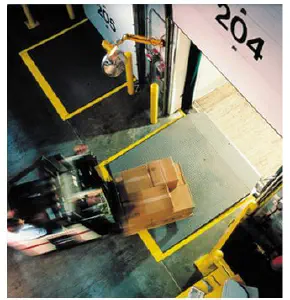Loading docks are the lifeblood of warehouses, distribution centers, and manufacturing
facilities, where the rapid loading and unloading of goods directly impacts productivity and profitability.
Hydraulic dock levelers are vital in maintaining a seamless operation in these hubs of activity, providing a sturdy,
reliable platform that bridges the gap between the dock and a transport vehicle. This article will delve into the
workings, benefits, and considerations surrounding hydraulic dock levelers and their key role in modern logistics.
What are Hydraulic Dock Levelers?
Hydraulic dock levelers are permanent fixtures at the loading dock that provide an
adjustable platform to compensate for the height differences between the dock floor and the truck or trailer bed.
Unlike mechanical levelers, which require manual lifting, hydraulic levelers are powered by pressurized fluid,
allowing for smoother, effortless operation at the push of a button.
How Hydraulic Dock Levelers Work
Hydraulic dock levelers operate with the help of an electrically powered hydraulic system
that raises and lowers the leveling platform. When a truck backs into the docking station, the leveler is activated,
and the hydraulic system engages to bring the leveler plate up to the truck bed's height. Once in place, the plate
is extended into the truck, creating a secure, flat ramp for forklifts and other loading equipment to move goods
across. After the loading or unloading process, the leveler retracts and returns to its default position, flush with
the dock floor.
The Advantages of Hydraulic Dock Levelers
Efficiency: Hydraulic levelers streamline the loading process by allowing for quick
adjustments to truck heights, reducing wait times, and enhancing overall dock throughput.
Durability: Designed to withstand heavy loads and frequent use, hydraulic dock levelers are
built to last, making them a sound long-term investment for high-traffic docks.
Safety: With smoother transitions and fewer parts to manage, hydraulic levelers minimize the
risk of accidents and injuries caused by tripping or equipment malfunction.
Ease of Use: Their simple push-button operation reduces physical strain on workers and
eliminates the need for manual lifting required by mechanical alternatives.
Lower Maintenance: With fewer moving parts than mechanical levelers, the hydraulic system
requires less maintenance, leading to lower ownership costs over time.
Types of Hydraulic Dock Levelers
Hydraulic dock levelers come in various configurations to suit the needs of different
loading dock operations:
Pit-Mounted Levelers: Installed in a recessed pit at the dock door, these levelers provide
full-width accessibility and can accommodate a wide range of truck heights.
Vertical Storing Levelers: Perfect for temperature-controlled or clean environments, these
levelers store vertically, allowing dock doors to close flush to the floor, minimizing energy loss.
Edge-of-Dock Levelers: Best suited for docks with minimal height variation, these levelers
mount directly to the dock face and provide a smaller range of motion.
Safety Features and Customization
Sophisticated hydraulic dock levelers feature an array of safety features, including
automatic return to safe positions in the event of a power failure, velocity fuses to prevent free-fall in the case
of sudden truck departure, and anti-skid surfaces to enhance traction. Furthermore, they offer customization options
to match specific industry needs, such as food processing, where hygiene is critical, or heavy industry, where load
capacity and durability are paramount.
Maintenance and the Importance of Regular Service
To ensure reliable operation and extend the lifespan of a hydraulic dock leveler, regular
maintenance is essential. Periodic servicing should include checking the hydraulic fluid levels, inspecting hoses
and fittings for leaks, testing the system's safety features, and cleaning debris from the pit and platform. A
planned maintenance schedule, typically facilitated by the equipment provider or a specialized service company,
prevents unexpected downtime and repairs.
Considerations When Selecting a Hydraulic Dock Leveler
When choosing a hydraulic dock leveler for your facility, consider the following:
Loading Requirements: Assess the types of vehicles your dock will service and the range of
height differences you'll encounter.
Volume of Traffic: Determine the frequency of your loading activities to select a leveler
robust enough to handle the daily throughput.
Environmental Control: Evaluate whether you need features that support energy efficiency or
cleanliness, such as a vertical storing leveler.
Budget: While hydraulic levelers can be more expensive initially, reduced maintenance and
longer lifespans might make them a better investment over time.
Warranty and Support: Look for reputable manufacturers offering strong warranties and
reliable support services.
Hydraulic dock levelers are a crucial element in the efficient operation of any loading
dock. They provide smooth, reliable operation, enhanced safety, and have become an industry standard due to their
efficiency and ease of use. With the right selection, installation, and maintenance, a hydraulic dock leveler can be
a dependable workhorse, ensuring that your loading dock meets the demands of an ever-accelerating supply chain.
The modern logistics landscape demands equipment that can keep up with the pace of global
trade while ensuring worker safety and goods integrity. Hydraulic dock levelers meet these requirements, providing
businesses with a powerful tool to maintain an edge in a competitive market. As technology evolves, these loading
dock stalwarts continue to adapt, incorporating smarter features and advanced safety measures, ensuring that they
remain at the forefront of loading dock efficiency for years to come.

